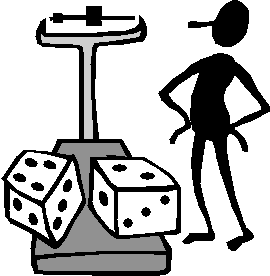Analyzing Categorical Data
Risk Ratios and Odds ratios
In analyzing epidemiological data one is often interested in calculating the risk ratio (RR, sometimes referred to as relative risk), which is the ratio of the risk (probability) of disease among the exposed compared to the risk (probability) of disease among the non-exposed. It indicates how many times the risk is increased in "exposed" subjects compared to unexposed subjects. In this situation the "exposures" are the various foods that may have been consumed, so we would want to compute the RRs comparing people who ate a particular food item to those who did not eat that item.
One can also calculate the odds of disease among those who ate a given food and the odds of disease among those who didn't eat it. From these, one can compute the odds ratio. For a more complete explanation see the following epidemiology module
Note that in case-control studies one, but one can compute an odds ratio. annot compute a risk ratio, For a more detailed explanation refer to these epidemiology module: Measures of Association.
> table(case)
case
FALSE TRUE
625 469
The probability of being a case is 469/length(case) or 42.9%.
On the other hand the odds of being a case is 469/625 = 0.7504.
R has a number of packages that you need to install to use; these calculate odds ratios, relative risks, and do tests and calculate confidence intervals for these quantities. (Although we can also calculate these by writing our own code!) Some examples are the packages epitools, epiR, epibasix, which can be installed from the CRAN website. Here we'll use epitools.
>library(epitools)
> riskratio(beefcurry[which(beefcurry!=9)], case[which(beefcurry !=9)])
# risk ratio for cases among those eating beef curry, removing the missing
$data
Outcome
Predictor 0 1 Total
0 69 22 91
1 551 447 998
Total 620 469 1089
$measure
risk ratio with 95% C.I.
Predictor estimate lower upper
0 1.00000 NA NA
1 1.85266 1.279276 2.683039
$p.value
two-sided
Predictor midp.exact fisher.exact chi.square
0 NA NA NA
1 0.0001033504 0.000144711 0.0001437224
- H0: There is no association between gastrointestinal illness and eating beef curry: RR = 1
- Ha: There is an association between gastrointestinal illness and eating beef curry: RR ≠ 1
When testing the null hypothesis that there is no association between gastrointestinal illness and eating beef curry we reject the null hypothesis (p = 0.000143). Those who ate beef curry have 1.85 times the risk (95% CI 1.28, 2.68) of having gastrointestinal illness in comparison to those who did not eat beef curry.
> oddsratio(beefcurry[which(beefcurry!=9)],case[which(beefcurry !=9)])
$data
Outcome
Predictor 0 1 Total
0 69 22 91
1 551 447 998
Total 620 469 1089
$measure
odds ratio with 95% C.I.
Predictor estimate lower upper
0 1.000000 NA NA
1 2.530309 1.564366 4.251073
$p.value
two-sided
Predictor midp.exact fisher.exact chi.square
0 NA NA NA
1 0.0001033504 0.000144711 0.0001437224
When testing the null hypothesis that there is no association between gastrointestinal illness and eating beef curry we reject the null hypothesis (p = 0.000143). Those who ate beef curry have 2.53 times the odds (95% CI 1.56, 4.25) of having gastrointestinal illness in comparison to those who did not eat beef curry.
|
Calculate the odds ratio and relative risk of developing food poisoning for those who had eaten éclairs. [Hint: first create a variable "eclair.eat" to enumerate people who had eaten eclairs] |


 Probabilities always range between 0 and 1.
Probabilities always range between 0 and 1.
